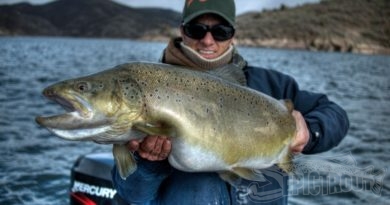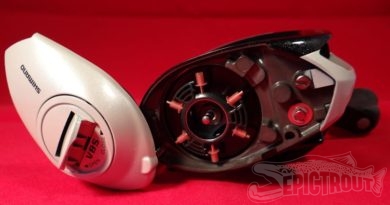Tips
Master Tech: 5 tips for better German brown fishing
Shangle’s note: The following Master Tech story comes from CS’s roving trout bum, Chris Shaffer
Regardless of what you hear or read, there are only two kinds of anglers that catch German browns in California: those who do so on accident, and others who spend obsessive amounts of time chasing them.
Unlike rainbows, brown trout aren’t easy to catch. They’re predators, they’re wary of danger, and they only tend to put themselves in vulnerable positions under certain circumstances. It takes skill and patience to catch them consistenly.
Especially when you’re talking trophies. Hands down, anglers who catch the most trophy browns are those who are well educated in the sport, have patience and know how to properly approach the species.
Right now is perhaps the best time of the year to pursue them as browns leave the depths and creep to the surface to feed for a month or so prior to their annual spawn. The great thing is that not all browns spawn at the same time: early October through November can be excellent months to target trophy browns (in lakes that remain open, of course).
Fall can be an excellent time to catch trophy fish at places like Lake Almanor, Lake Tahoe and other known big-brown factories, but you’ll need to master a few concepts to guarantee success. Here are five must-know tips that can help you catch more browns than ever before.
1. Track the weather
Regardless of how skilled you are, trophy brown trout fishing is routinely poor throughout the summer. In fact, most successful brown trout anglers don’t even bother to start fishing for them until the middle of September (and that’s even early). In summer, browns tend to be located in portions of the water column that can be a challenge to fish: Namely, deep, deep.
It’s better to hold off on your brown-bagging excursions and focus on a period when you know the probability of catching a quality brown is better. Like right now.
Brown trout fishing doesn’t normally get good until after a lake turns over, but once the thermocline breaks apart, browns tend to start to creep to the surface to feed. Your best indications that this will take place are falling water temperatures and shorter days. Cooler temperatures, both air and water, promote great brown trout fishing, but it usually takes a few weeks of fall-like conditions before browns even think of moving shallower.
“The window of opportunity in the fall is much smaller than it is in the spring,” says well known brown trout guide Mike Nielsen of Tahoe Topliners Guide Service (tahoetopliners.net) in Lake Tahoe. “In the fall, once they get in their spawn mode they don’t want to bite anything. The rewards can be huge on the fall fish because they’re fat and ready to spawn. The spring fish are thinner after they’ve got done spawning and the lake has been frozen over. They’re actively looking for food in the spring, but they’re usually smaller.”
2. Learn the art of patience
Once you determine the ideal fall conditions have been met, it’s even more important to prepare yourself to BE PATIENT. I can’t stress enough that browns aren’t like rainbows; p of the reason it’s special to catch trophy browns is because they take work to catch, and hookups aren’t as common. If it was easy to catch browns, there wouldn’t be as much hoopla involved as there was when, for example, Nielsen brought a 14 and a pair of 15-pound Tahoe monsters aboard his boat between 2009 and this spring.
Be primed to fish for several hours, if not days, at times, without catching many browns. Unlike rainbows, which are predictable, you never know when the browns are going to be active, but once the bite starts, expect it to last for several weeks.
When this happens, the early morning, late evening and twilight bite (when there’s a full moon) should yield great opportunities to nab trophy browns throughout the West Coast.
“A successful brown trout fishermen needs to put a lot of time on the water,” Nielsen confirms. “That means fishing consistently enough that you’re there when the fall bite begins. That may be a week or a month without catching a lot of fish. Having to take that time and not always catching fish is tough for a lot of people, but you’ll also catch plenty of rainbows while you’re fishing for browns.”
That patience pays dividends the moment you catch a trophy brown. The power, strength, beauty and force of a brown is unmatched by most other North American trout species.
3. Employ smaller baits
Yes, I said s-m-a-l-l-e-r.
It’s no secret that big browns eat big baits. but in the fall, there’s a limit to how large of a bait you want to use. In the spring, browns are looking for a huge meal after they’ve come out of the spawn and icy conditions, and food has been scarce for a few months. This is when medium size swimbaits, plugs and large stickbaits are effective.
Fall can be entirely different. Many full-time guides and longtime brown chasers believe that downsizing can help boost catch rates.
“A lot of times I’m catching the rainbows on smaller baits and then the browns will start biting them, but when I put the bigger lures out there I get far less strikes. They seem to eat bigger stuff in the spring,” Nielsen says. “I’ve found that in the fall the browns are worried about spawning and staging to spawn, not actively feeding. With the smaller baits it’s an easy meal. They’ll snap at it. A lot of times they won’t chase down a huge meal because they are conserving energy for the spawn.”
Brown trout anglers have a different perspective when speaking of smaller baits than rainbow trout anglers do. By “small,” they aren’t referring to small spoons, rather medium stickbaits. Nielsen said that in the fall he uses fall colors, perhaps black and orange, orange and yellows in 3.5-inch Rapalas. You can also troll Rebel Minnows and a B14 Bomber Long A.
Legendary brown trout angler an AC Plug inventor Allan Cole agrees with Nielsen’s theory of downsizing in the fall.
“That’s what they bite, skinny lures,” Cole says. “I’ve been trying everything for decades and they always bite the skinny type lures most of the time. I’d say that four of five times they bite the skinny type lures.”
Cole runs 5- and 6-inch lures in the fall.
“In the spring I get them on the bigger stuff, but not in the fall,” he says. “They hit my AC Skinny Plug in the fall, but not many of the other ones.”
4. Water Conditions
According to Cole, there’s no single factor more important than water conditions when chasing fall browns. water conditions not favorable it doesn’t matter how good of an angler you are, most likely the brown trout won’t bite.
Cole bases his brown trout fishing around days when the surface is choppy. Rain, snow, sleet and moderate wind are ideal, he says, whereas bright, sunny days tend to yield poor fishing on browns. Cole is a strong believer that you need some sort of rough water to entice big browns to come to the surface and feed. If conditions are flat calm, the only legitimate chance you have of success is fishing at night or prior to the sun touching the water.
“The colder weather has to come in. If you have summer weather that stays they wont bite that good,” Cole said. “When the weather starts changing to fall-like weather after a long summer they’ll bite. If it’s warm they won’t bite.”
5. Go long … lines, that is
Neither Nielsen or Cole can stress the point enough that browns are completely different than rainbows. Unlike a rainbow, browns are unlikely to strike a lure that’s within your boat wake or following close behind your trolling route. By habit, they are wary. This is why Cole, Nielsen and many other brown trout legends run extremely long lines.
It’s impossible to have a specific number of how far your lure should be behind your boat. This depends on water conditions, time of day, boat traffic, the lure you are using, etc. Nevertheless, if you think your lure is out far enough, let it out a little further.
“You want to get away from the boat more, although I’ve caught browns right behind the boat,” Cole said. “Really it depends on where you’re fishing, but early and late in the day you can run shorter lines. It’s judgment on what condition you’re in.”
In lakes and reservoirs where the water is clear – Like Tahoe or Trinity or Stampede – you’ll want to run your lines out longer than normal, whereas in off color conditions and when there’s a chop on the water, you’ll be able to get away with shorter lines. Again, it’s important to adapt to the conditions you are faced with. Keep in mind, browns are finicky. The more measures you take to ensure that you wont spook the browns, and that you are on the water at the optimal time that browns will be feeding will drastically increase catch rates.
-Chis Shaffer






